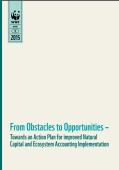
Over the last decade a consensus has been growing that accounting for natural capital and integrating that approach in governmental and business decision-making is an important pillar of global, national, regional, local and corporate conservation efforts. Accounting for natural capital aims to support halting biodiversity loss and avoiding the deterioration of ecosystems and the services they provide that underpin human well-being and economic prosperity. The Global Biodiversity Outlook (GBO-4) published in 2014 states that progress has been made in mapping and assessment of biodiversity, ecosystems and their services and in incorporation of their values into planning processes and strategies. However, there is still relatively little attention given to the integration of natural capital accounting into national reporting and accounting systems.
Attempts to govern, sustainably, the global environment and manage the world economy without destabilising crises, remain hopelessly disconnected. Since the original Earth Summit conference we have lived with an economic model based on debt-fuelled over consumption that coexists with vast levels of poverty and inequality. Comparable dynamics are visible in most economic sectors. Many working in the fields of environment and development now find that systematic problems require a systemic solution. This paper puts forward 6 challenges to lay the foundations for systemic change: Develop a national transition plan that puts countries on paths to operate within planetary boundaries, and on timescales sufficiently quick to preserve key, ecological life support functions; don’t start from a growth perspective; agree to develop and implement new measures of economic success; commit to reduce income and wealth inequalities between and within nations; put fiscal policy and public expenditure centre stage in managing economic transition; and recapture the financial sector for the public good.
For decades governments have allowed a single indicator, Gross Domestic Product (GDP), to assume dominance as the critical measure of a nation’s progress. It is now widely recognised by politicians and officials across the world that we must move beyond GDP and recognise it for what it is – a measure of economic exchange, which is itself a means to an end; the ‘end’ being the achievement of high well-being for all within environmental limits (‘sustainable well-being’). This paper focuses on ways of measuring environmental sustainability and well-being, and offers a view from the global South which entails measures of both of these. It calls for governments around the world to:
This paper proposes the establishment of a “plenty line” as a counterpart to the poverty line, as a means of focusing public and political attention on the issue of over-consumption. In other words, is there a level of income such that people with incomes above this level have minimally greater well-being than those with incomes at this level? While the analysis is complicated by the nature of the data available (viz. its reliance on self-reporting of income, and more specifically self-attribution to a limited range of income bands) and the relatively small sample sizes in most relevant surveys, the authors find indicative evidence for the existence of “plenty lines” ranging between household incomes of $35,000 and $107,000 in six Western European countries (and at $20,000 in one Eastern European country), where well-being is defined in terms of life satisfaction.

The Little Green Data Book provides key environmental data for over 200 economies, based on the World Development Indicators 2015 and its online database. Over 50 indicators are used, organized into categories on: agriculture; forests and biodiversity; oceans; energy and emissions; water and sanitation; environment and health; and national accounting aggregates. Data is presented for the regions of East Asia and Pacific, Europe and Central Asia, Latin America and the Caribbean, Middle East and North Africa, South Asia, and Sub-Saharan Africa.
The 2015 edition uses two new air pollution indicators: mean annual exposure to suspended particulate matter less than 2.5 microns in diameter (PM2.5); and percentage of total population exposed to PM2.5 pollution above the World Health Organization (WHO) Air Quality Guidelines (AQG) value of an annual average of 10 microns per cubic meter. Previous editions used indicators focused on the larger particulates (PM10) and only on urban centers with more 100,000 persons.
Also incorporated this year, are estimates of the economic costs of air pollution, including household air pollution from cooking with solid fuels.
